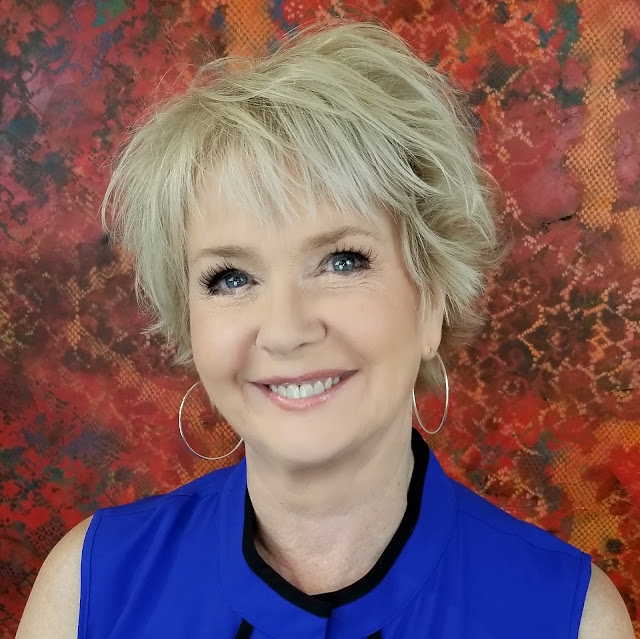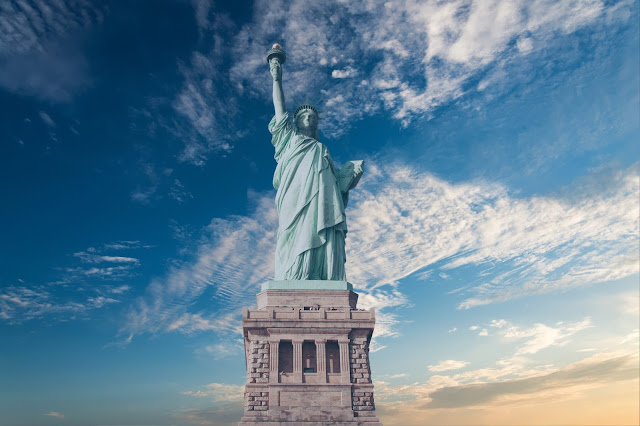 |
| Statue of Liberty (image via Pexels) |
6 November 2019
by Loup Dargent
November 06, 2019
5 November 2019
Education Related, Health Related, LGBT Related, Miscellaneous, News Related, Social Networking, Travel Related, US Related, Video-clips, Youth Related
by Loup Dargent
November 05, 2019
 |
| AsylumConnect Launches First Ever Mobile App For LGBTQ Asylum Seekers |
"Our free app instantly connects persecuted LGBTQ people with verified safe services and support. With today's launch, we have improved our platform's mobile accessibility and user experience at this pivotal moment for LGBTQ and immigrant communities," said Katie Sgarro, AsylumConnect co-founder and president.From leaving their dangerous home country to resettlement, it is often a matter of life-or-death for LGBTQ asylum seekers to be able to easily connect with legitimate and LGBTQ-affirming lawyers and other direct service providers.
LGBTQ asylum seekers and other LGBTQ populations (undocumented immigrants, homeless or isolated youth) use AsylumConnect as a free digital one-stop-shop referral site to meet their needs in all aspects of their lives, including: housing, legal, medical, mental health, education and employment.
- Lawyers and other direct service providers also use AsylumConnect to gather verified referrals.
The AsylumConnect mobile app on iOS and Android offers an improved user experience and new features:
- Streamlined user experience: improved content organization, new bottom navigation, and fresh designs throughout the app
- New verified resources and locations: at launch, the app connects users to verified LGBTQ-and immigrant-friendly services in 25 U.S. states, Canada and Mexico
- Anonymity: designed to protect users' privacy online
- Search filters: filter out services that require specific documentation (medical insurance, proof of age/income/residence, or a referral)
- Translation: available in over 100 languages
Next, AsylumConnect will introduce enhanced map visualization, offline capabilities, new locations and an integrated private online community for LGBTQ asylum seekers.Since launching in 2016, AsylumConnect has connected over 11,000 unique users to verified LGBTQ-and immigrant-friendly services in the U.S. and has been accessed in over 150 countries. Financial and in-kind supporters include: Roddenberry Foundation, U.S. Committee for Refugees & Immigrants, Clinton Foundation, Brooklyn Community Foundation Immigrant Rights Fund, One Degree, Urban Justice Center's Social Justice Accelerator, and Miller Center's GSBI Social Entrepreneurship at the Margins Accelerator.
About AsylumConnect
AsylumConnect is a tech nonprofit providing the first and only digital resource platform for LGBTQ asylum.About Katie Sgarro, AsylumConnect Co-Founder & President
Katie Sgarro is based in New York and is a social entrepreneur and LGBTQ advocate. During her senior year in college, she publicly “came out” in order to co-found AsylumConnect. Her experience denying her own LGBTQ identity drives her to ensure that other LGBTQ people live freely. Sgarro has led AsylumConnect for 5 years in establishing the first ever digital resource platform for LGBTQ asylum.
For her work on AsylumConnect, Sgarro was selected as the winner of MCC15’s Millennium Peace Prize at the United Nations and the 2015 Business Today Impact Challenge. In 2017, she was named to the Clinton Foundation’s Clinton Global Initiative University (CGI U) Alumni Honor Roll of social innovators and as a Mogul Influencer. Sgarro was also named a Washington Post’s WP BrandStudio Influencer in 2018. In 2019, Sgarro became a Roddenberry Fellow and joined Urban Justice Center’s Social Justice Accelerator. In 2019, Sgarro was also selected as one of 24 emerging nonprofit leaders for American Express Leadership Academy's Converge Academy in Brooklyn, NY.
She has been a featured speaker on LGBTQ rights and public good technology, and her work has appeared in national outlets including Teen Vogue, Forbes.com, The HuffPost, NowThis, The Advocate, and The Hill. She received a B.A. cum laude in Health & Societies from the University of Pennsylvania and a M.S. in Management from Northwestern University’s Kellogg School of Management.
- More about Sgarro can be found at her website www.katiesgarro.com
SOURCE: AsylumConnect

4 November 2019
by Loup Dargent
November 04, 2019
 |
| Windmills near green trees (image via Pexels) |
Reduce Our Energy Usage
Every one of us has a carbon footprint, and that’s how much energy and usage we have on our environment. Ideally, you want to make your footprint as small as possible, and that can only happen if you try to reduce your energy usage. The biggest will come from the household bills that you pay for every month. The gas and electric all have an impact on the environment, and the more effort you can make in reducing these, the better. Try to keep your heating off and only use it for short periods of time when needed. During the colder months, you want it on only to take the chill off the room. So for starters, you could time it to come on first thing in the morning as you’re about to wake up an hour before you’re due back from work. This means you’re waking up and coming home to a warm house. If you work from home, you can do the same and then intermittently turn it back. Keeping it on low all day is only going to continue burning through your usage, so be conscious of how much you are using. Try to reduce the amount of time spent using electrical items and practice turning everything off at the plug at the end of the day. That way, the electronics aren’t continuing to use power if they’re switched off.Travel By More Eco-Friendly Means
We all travel for different things, whether that’s for business or pleasure. We go on annual holidays, we travel to and from work, and we take trips to see family and friends on a regular basis. All of that requires you to travel by public transport or via car. Sometimes this is necessary, but it’s important to exhaust all other options first that aren’t harmful to the environment. If you’re taking a trip to the local shop, why not walk there? If your work is within a suitable distance and you feel confident enough, then cycling to and from your work doesn’t cost you anything and it provides you with a healthy boost of fitness every day. Not only that, but it’s not harming the environment.If you’re going on holiday, you could consider taking the train or going by boat to save on the fuel that’s used for planes. This isn’t always possible, but if you’re making a conscious effort to use these forms of transport here and there, it’ll make an overall difference. The less fuel we’re using, the better it’s going to be for the environment in the long run. There will always be a need for those who influence and hold power in the world to use organizations like the ACS, but having fewer commercial flights will save on fuel.
Reuse Rather Than Buy New
A lot of focus recently on how fashion is becoming a big contribution to waste. Fast fashion, as it’s called, is where people are buying clothes and then chucking them out once that season ends or another trend comes in. Instead of maybe reusing clothing, they’re spending more money on clothes that have to be made out of materials and therefore causing more overall waste in the world. Try to shop from more sustainable brands that are recycling and reusing materials. The same goes for a lot of things within your lifestyle. For instance, a lot of furniture that you have might be in perfectly good condition, but instead, you want to chuck it out. Look at what you can do to upgrade its appearance, either by adding to it or maybe reupholstering it if it’s a sofa or armchair. These items of furniture can still provide you with a lot of usages, and if not, then it can always go to someone else rather than being chucked away.Grow Your Own Food
Ever wanted to grow your own food? Well, now a lot of households are adapting to the sustainable life by growing their own food sources.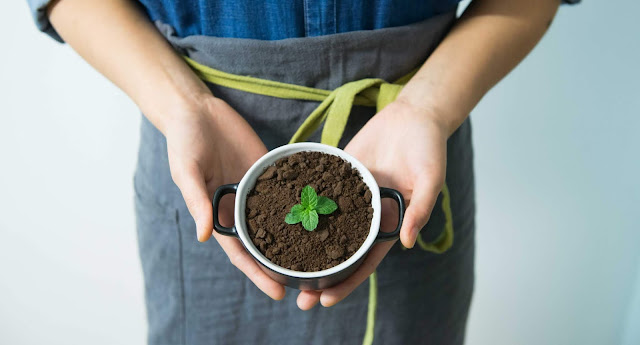 |
| Person Holding Cup With Green Plant (image via Pexels) |
Donate Your Unwanted Things
We do tend to find that we’ve hoarded a lot of things in our lifetime, and there may come a time where a good decluttering is in order. It can be beneficial to our mental health if our space is tidier and more well-organized. With that in mind, it might be worth arranging a collection or dropping off those items that you don’t need anymore to a shelter or shop that will sell them on or give them away to those who need it. What is one man’s waste is another man’s treasure, so donate any of your unwanted things to those who can benefit from it. Always check that they’re in good condition and only throw away items that have broken to the point that they’re useless and no longer usable.Save The Water
Saving water is important because wasting it is only going to use more energy in order to help source more of it. You can help by saving water in your household. Don’t use outside taps, and instead, try to conserve any water in an outside tank system or something that will just collect rainwater. It’s not going to matter how dirty it is because you’ll only be using it for watering plants and other outdoor tasks that need doing. Try not to leave taps running for too long and turn off the tap when you’re brushing your teeth. That way, you’re not letting so much water pour down the drain while you’re busy cleaning your teeth for two minutes.Remove Plastic From The Household
And finally, the biggest victim of the environmental clean up is plastic. Plastic is everywhere, and we use so much of it within our home. From the packaging that our goods come in, to the plastic storage tubs that we use for food and various other bits and bobs. Try to live a more plastic-free lifestyle where you can. Buy from more companies that use plastic-free or biodegradable packaging.The more your household can do, the bigger impact it will have as more and more of us take notice of how much we’re affecting the environment. Do what you can as a little certainly goes a long way.
3 November 2019
Entertainment Related, Miscellaneous, Music Related, News Related, UK Related, US Related, Youth Related
by Loup Dargent
November 03, 2019
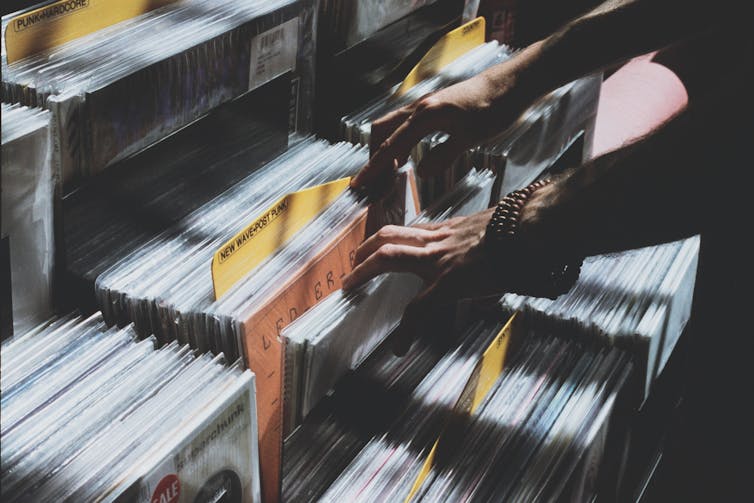
In an era when so much music is at our fingertips through streaming services for under $10 a month, who is spending their hard-earned cash on vinyl? Streaming is currently the primary and cheapest way to buy music. According to the Recording Industry Association of America (RIAA) database, paid subscription streaming services such as Spotify dominated music sales revenue in the U.S. in 2018, accounting for almost 50 per cent of revenue. But cassettes, CDs and digital downloads have all held that position in the past.
Teens of the 1980s (now aged approximately 45 to 54) and the ‘90s (now aged approximately 35 to 44) were the two largest age demographics buying vinyl in 2018, accounting for 24 and 21 per cent respectively of new vinyl sales in the U.S., according to 2018 data from the RIAA.
Vinyl’s lasting influence
Sales data shows that cassettes first surpassed vinyl LP sales in the U.S. in 1983. Then CDs surpassed cassette sales in 1991.At that point, vinyl LPs disappeared from most music stores, remaining only a DJ specialty. They accounted for only 0.8 per cent of total music sales.
Tim Ford, vice-president of purchasing at Sunrise Records, says he recalls feeling forced to buy CDs in the '90s because they were cheaper than vinyl and more widely available for him as a broke teenager. Now, Ford and many other '80s and '90s kids are working adults with disposable incomes. Ford says 35-to-40-year-olds want music from their generation like their parents had.
These consumers are used to the concept of owning music, but now they want vinyl, because they think it’s better quality, and they have the money for it.
Michael Greaves is another example of this type of vinyl consumer; he was a DJ in the '90s and has a collection of 1,200 CDs — many of which he bought eight for a penny. Now he works full-time as a music administrator and is an avid vinyl collector.
Greaves says he buys vinyl because “with vinyl you get a warmth you don’t get with CDs.” There’s just something about the crackle of a vinyl record that makes people feel at home.
Owning a physical copy
No artist is forced to put his or her music on streaming services and not every artist even has the legal right to do so. The popular albums of the ‘80s and ‘90s that aren’t being widely reissued are going for hundreds of dollars on resale sites.A mint-condition vinyl LP of De La Soul’s 1989 album 3 Feet High and Rising, for instance, is selling for more than $360 on Discogs. That album isn’t being widely reissued and is now unavailable on paid subscription streaming services such as Tidal, which is said to be because of artist and label disputes.
The initial excitement about streaming services seems to have worn off since Spotify launched in Sweden in 2008. Consumers are now seeing flaws in streaming, one of them being that we can never be fully assured of access to their favourite songs without owning a physical copy of them.
Andrew Winistorfer, editorial director at Vinyl Me, Please, a record-of-the-month club, says that young people today accept that you don’t own music. CD sales were at their height at the same time that music piracy became popular and almost destroyed the music industry.
However, the young today still account for part of the new surge in vinyl sales. Winistorfer explains that vinyl is “the cooler way to have … a physical manifestation of this music that you like.”
Willing to pay
RIAA data shows that 25-to-34-year-olds and 18-to-24-year-olds accounted for 19 and 16 per cent respectively of U.S. new vinyl sales in 2018. This is valuable to artists who are not being paid what they’d like to be on streaming services. For artists, selling other merchandise has become increasingly important.Luckily for them, some fans are willing to pay for exclusive merchandise and experiences on crowdfunding platforms. A 2013 Indiegogo campaign for the Canadian band Protest The Hero raised nearly $450,000 to fund an album and 1,299 copies of the signed, limited-edition vinyl LP were claimed as rewards.
Katy Perry has a vinyl record coming out soon. It’s a record-first release but her truest “Katy Cats” will surely snatch up those 4,000 copies quickly to be able to hold a piece of their favourite artist in their hands.
Consumers have less control than they might think over what music they can access. What will happen if one day your favourite artist doesn’t have the resources, desire or legal right to keep your favourite songs up on a streaming service? What if you simply want to hold the music you love in your hands? Teens of the 80s and 90s would probably tell you to buy the album — on vinyl.
About Today's Contributor:
Marina Eckersley, Dalla Lana Fellow in Global Journalism, University of Toronto
This article is republished from The Conversation under a Creative Commons license.
1 November 2019
by Loup Dargent
November 01, 2019
Faisal bin Muammaar, Secretary General of the International Dialogue Centre (KAICIID) announced an allocation of nearly 1.5 million Euros for initiatives aimed at countering hate speech across the Centre's global programmes in 2020.
"The advent of the digital age has magnified the effects of antisemitism, Islamophobia, xenophobia and other manifestations leading to the isolation of individuals and groups on the basis of their identities, whether faith-based, gender-based or race-based," bin Muammaar said.The investment, announced at an international conference organised by the Centre and attended by nearly 200 delegates and guests from all over the world, is intended to further align KAICIID's activities with the United Nations Plan of Action on Hate Speech announced earlier this year. The Centre was also involved in discussions leading to the 2017 UN Global Plan of Action for Religious Leaders and Actors to Prevent and Counter Incitement to Violence That Could Lead to Atrocity Crimes and has made countering incitement and hate speech a key component of its programmatic outreach.
"The Centre aims to enhance the positive role of religious leaders and their institutions in countering hate speech and contributing to social cohesion at local and regional levels. To this end, I can announce that KAICIID is investing nearly 1.5 million Euros in 2020 towards the implementation of the recommendations and action plan agreed by this conference."
KACIID's initiatives for next year will be administered in its focus countries and regions, comprised of Nigeria, the Arab region, Myanmar, Europe and the Central African Republic. They will include:
- Social media campaigns against hate speech and training for vulnerable groups such as women and people seeking refuge to counter the phenomenon.
- Supporting existing efforts and assisting in launching new national initiates to counter hate speech.
- A tailored training programme for media experts, journalists and social media influencers on the responsible use of their channels.
These commitments follow an allocation this year of almost 900,000 Euros which have also been directed at programmatic interventions dealing with hate speech and its impact on social cohesion. This allocation is in addition to amounts spent in other programmatic activities.
The announcement was made during the conference entitled "The Power of Words: The Role of Religion, Media and Policy in Countering Hate Speech," which had keynote contributions made by the former Austrian President Heinz Fischer; Adama Dieng, Special Advisor to the United Nations Secretary General for the Prevention of Genocide; and Ján Figel, Special Envoy for the promotion of freedom of religion or belief outside the European Union.
During his keynote address, Fischer told delegates: "If a word can have such an impact and such relevance, we can imagine what damage hate speech can bring to a human being, to a community, to society and to the principle of peaceful dialogue and respectful cooperation.
I accepted this invitation with pleasure, because I am ardently against hate speech and I am convinced that the overwhelming majority of the Austrian population is supporting this position. Fighting against hate speech is an essential element of defending human rights," the former President of Austria said.
Dieng for his part expressed concern over the growth of hate speech worldwide in recent years and commended KAICIID's work in the field. "At the United Nations we extremely value the work of KAICIID. We extremely value the convening of this first and historic conference on the power of words. We have to remember that the holocaust did not start with the gas chambers. It started much before with words. Words kill," he said.
Cardinal Miguel Ayuso Guixot, President of the Pontifical Council for Interreligious Dialogue, who represents the Holy See at KAICIID's Council of Parties and is a member of the Centre's Board was one of the high level religious leaders opening the conference. "World peace through human fraternity is not some idealistic dream but a reality that has emerged, taken hold in concrete ways, in events such as this, fostering dialogue and understanding. KAICIID is a living example of the efforts to counter hate speech, not only through the media, but by the very experience of working together to better relations and understanding between religions," he said.The bulk of conference delegates were from the Arab region, where hate speech has been a major cause of division and violence. H.E Sheikh Abdallah bin Bayyah, President of the Forum for Promoting Peace in Muslim Societies and religious leaders representing the Arab region's Christian, Druze, Jewish, Muslim and Yazidi communities also attended. Many of them are part of the KAICIID-supported Interreligious Platform for Dialogue and Cooperation in the Arab World. The conference also received contributions by members of organisations such as the KAICIID-supported Muslim Jewish Leadership Council (MJLC), as well as other European experts, in order to produce shared perspectives and initiatives common to both regions.
The conference created specialist panels of experts to discuss countering hate speech in the policymaking, religious, media and educational fields. Delegates produced a special declaration and an action plan.
31 October 2019
Education Related, Entertainment Related, Geeky Stuff, Miscellaneous, News Related, Trailers, Video-clips, Youth Related
by Loup Dargent
October 31, 2019
Robotics is not just the stuff of sci-fi movies anymore, but something every child can – and should – learn to develop skills that employers are already prizing. That is the mission of World Robot Olympiad: to introduce STEM through fun robotics competitions and connecting thousands of children and youth regardless of their nationality and background.
They met, and despite the fact they didn't share a language, they talked 2-3 hours about building better algorithms and robots. The first year they communicated in English. The second year Adib was fluent in German and they won 1st place in the German national WRO final.
• More than 27,000 teams are participating in national WRO competitions in 2019.
• The international WRO final attracts 400 teams from 65 countries and 3,000 visitors.
• Teams consist of two to three young people supervised by a coach.
A new documentary – ME & MY ROBOT – follows several WRO teams to show how robotics impact the way kids see and interact with the world around them. The documentary premieres November 8 during the international final in Hungary, and will be part of a campaign to inspire students to explore their interest in STEM.
Trailer for ME & MY ROBOT
New friend, bonus family and first place
Fabian and Adib are two of the kids featured in the documentary. The story of how they became a team is remarkable. In 2016, Adib moved from Syria to Germany with his family, because the situation in Edlib had become too dangerous. His plan was to continue with robotics in Germany, maybe to forget about the war and leaving home. To find a partner, Adib looked for participants in robotic competitions and came across Fabian, who appeared to be the only other teenager in the state working with robotics in their age group. By a stroke of luck Fabian went to a school in Halle, Adib's new home town.They met, and despite the fact they didn't share a language, they talked 2-3 hours about building better algorithms and robots. The first year they communicated in English. The second year Adib was fluent in German and they won 1st place in the German national WRO final.
Adib says: "The main reason I speak German is because of Fabian's parents. I went climbing, swimming, and skiing with the family. They showed me how cool Germany is and have helped me a lot with practical things. They still do."
'Where else could this happen'
Last year at the international WRO final in Thailand, Adib and Fabian talked to the Russian team. They communicated through Google translate, exchanged email and are still developing algorithms together.Adib says: "They build algorithms on top of ours, which is extra cool. Where else could this happen: Syrians, Germans and Russians coding together? This kind of experience can't be taught at university or on your own. You have to exchange ideas and learn from other experienced people."Adib's and Fabian's passion for robotics and LEGO have been passed on to their younger brothers, who now participate in WRO. Word of mouth is one way to acquaint more kids with STEM. Another is collaboration between NGOs, companies, governments and universities who want to help foster the engineers and inventors of tomorrow. Like the international WRO final in November which is hosted by the Hungarian government and Edutus University – and ME & MY ROBOT, which is presented by Juniper Networks and executive producer James Redford.
Facts
• The documentary was filmed up to and during the international final in Thailand 2018.• More than 27,000 teams are participating in national WRO competitions in 2019.
• The international WRO final attracts 400 teams from 65 countries and 3,000 visitors.
• Teams consist of two to three young people supervised by a coach.
SOURCE: World Robot Olympiad Association
Related Video:
30 October 2019
by Loup Dargent
October 30, 2019
 |
| A sample of over 400 Dolls and Automata from the collection of mysterious heiress, Huguette Clark, to be auctioned by Theriault's |
Among the treasures she left behind in her Manhattan 5th Avenue penthouse were paintings by Monet and Renoir, violins by Stradivarius, jewels from Cartier and her famed collection of rare antique dolls.
The doll collection will be auctioned by Theriault's, the international doll auction firm, at a special event to be held in Santa Barbara on January 11th and 12th, 2020 to benefit The Bellosguardo Foundation which oversees the historical coastal property in Santa Barbara, CA bequeathed by Huguette Clark as a future center for the arts.
- A small collection of historically relevant dolls will be curated by Theriault's and retained by Bellosguardo for inclusion in the home display.
The dolls will be presented in a commemorative catalog which includes many historical references concerning the life of Huguette Clark including such unique correspondences as that with Christian Dior, the iconic fashion house which created custom costumes for some of her 19th-century fine French bebes.
 |
| Huguette Clark at Columbia Gardens, Butte, Montana |
About Huguette Clark:
(Via Wikipedia)
Huguette Marcelle Clark (June 9, 1906 – May 24, 2011) was an American heiress and philanthropist, who became well known again late in life as a recluse, living in hospitals for more than 20 years while her various mansions remained unoccupied. She is the subject of the No. 1 bestselling biography Empty Mansions and the planned film based on the book.
The youngest daughter of Montana senator and industrialist William A. Clark, she spent her early life in Paris before relocating with her family to New York City, where she was educated at the Spence School. After a short-lived marriage ended in 1930, Clark returned to her residence at 907 Fifth Avenue, a large twelfth-floor apartment that she significantly expanded to occupying two floors. She also meticulously maintained Bellosguardo, a large familial estate in Santa Barbara, California, though she never returned to the property after the 1950s. [Click here to read more...]
About The Bellosguardo Foundation:
Huguette Clark bequeathed her magnificent Santa Barbara estate to the Bellosguardo Foundation in order to transform it into a focal point for art and culture. For more than half a century, the estate has stood frozen in time. The Foundation is committed to honoring the Clarks' legacy, while transforming Bellosguardo into a center for art, music, history, and culture on the California coast.
SOURCE: Theriault's

29 October 2019
Canada Related, Education Related, Miscellaneous, News Related, Politically Yours, UK Related, US Related
by Loup Dargent
October 29, 2019
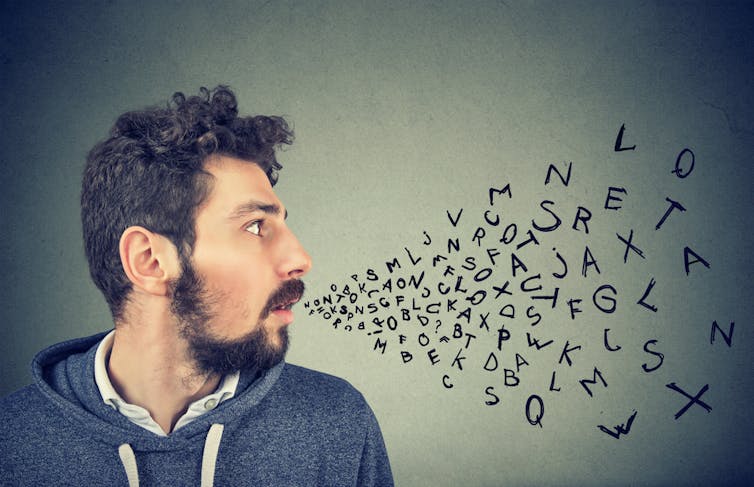 |
| It’s not what you say… it’s how you say it. (Shutterstock) |
The cartoon is still regularly shared on social media in the context of the debate around unconscious, or automatic, bias. This bias can happen when people unknowingly favour people who appear to be more like themselves, and discriminate against those who appear “different”. Examples include white people being more likely to find black male faces more threatening, or applicants with ethnic minority sounding names being less likely to get a job interview, even when they have the same qualifications.
Many employers now require their employees to take courses aimed at making them aware of this bias. Judging another person’s capability or credibility based on their gender, race or whether they use a wheelchair is obviously discriminatory, as such characteristics are unrelated to competence and expertise.
What accents say
But most people never stop to reflect on the degree to which accent can affect their opinion of the person speaking – particularly (but not only) if the accent gives the speaker away as someone who did not learn the language as a native speaker.A particularly disturbing example was recently reported in the form of a judgment by Canadian judge Terry Clackson. The judgment lists in great detail a range of grammatical and phonetic “errors” committed by the Crown’s expert medical witness, Dr Bamidele Adeagbo – who is of Nigerian descent – rejecting the expert opinion delivered in his capacity as the physician who performed an autopsy that was a key element in the case.
In the present day and age, one would very much hope that stereotypes based on race, gender or sexual identity would not be seen as remotely acceptable arguments in a court ruling. So how can a supposedly imperfect command of the English language by someone who did not have the good fortune of being born and raised in what linguist David Crystal has termed an “inner circle” country – such as the UK, the US or Canada – be acceptable grounds for dismissing their considerable expertise?
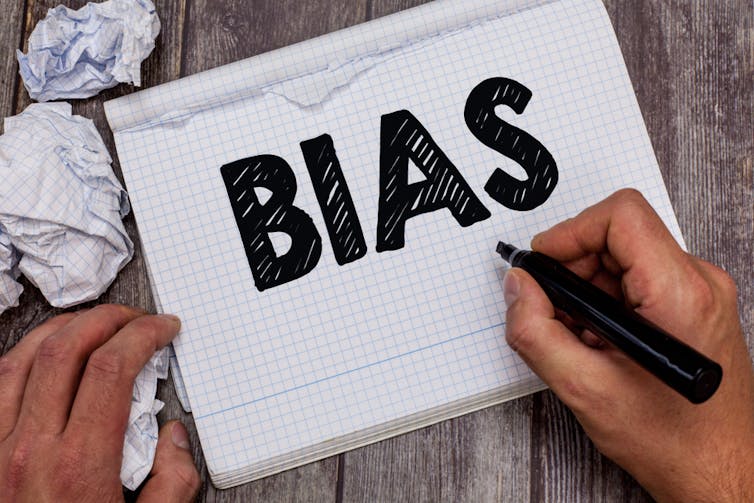 |
| ‘You’re not from 'round here!’ (Shutterstock) |
How well we speak the language therefore is a measuring stick for how competent we are at anything else. As the linguist Vivian Cook pointed out, foreign language speakers are typically evaluated not on the basis of how far they have come, what they have achieved and how much they are able to do, but by the gap that still separates them from the “ideal” native. The enumeration by Justice Clackson of the imperfections in Adeagbo’s use of English is a textbook example of such an evaluation.
Such biases are particularly common in societies where it still is considered the norm for people to grow up speaking only one language, and where foreign language learning is deemed to be a “useless” luxury – although similar biases have been shown to apply among other non-natives who presumably should share the pain.<
‘Where are you from?’
Even more disturbingly, labelling someone as “foreign”, with all the prejudices and stereotypes that this incurs, is something that literally happens within a split second. One study found that judgements on whether or not a speaker is a native can be surprisingly accurate upon hearing a speech segment that is just 30 milliseconds long.Certainly, after a sentence or two, the listener will have made up their mind – and often will follow it up with the inevitable and ubiquitous question: “Oh, where are you from?” At that point, you know you have been labelled – and that your credibility is in tatters. What you say is now less important than how you say it.
While it is essential that these prejudices should be called out and recognised as part and parcel of unconscious bias, and that we should try to work against them, it is clear that this will have to be a marathon, not a sprint. The view that someone with a more “native” command of a language must be more knowledgeable than one who doesn’t – even if we are talking about a non-native who is considerably more expert – is deeply rooted and hard to challenge.
In an ideal world, society should treat everyone as equal, regardless of their wealth, power, status, race, gender – or accent. We do not live in such an ideal world. But there is a reason why many societies represent Lady Justice as wearing a blindfold: the judiciary must put facts and expertise in the balance and be able to abstract away from base prejudices.
“Thank you for your excellent analysis, Dr Adeagbo – perhaps a native speaker would care to present it?” is simply not good enough.
About Today's Contributor:
Monika Schmid, Professor of Linguistics, University of Essex
This article is republished from The Conversation under a Creative Commons license.
Books Related, Campaigns, Entertainment Related, How To, Miscellaneous, News Related, Politically Yours, US Related, Video-clips, Youth Related
by Loup Dargent
October 29, 2019
 |
| War on Us: How the War on Drugs and Myths about Addiction Have Created a War on All of Us. - Book Cover |
We've all become victims of this war, observes Colleen Cowles, a lawyer, speaker, teacher, advocate and author of the new book, War on Us: How the War on Drugs and Myths about Addiction Have Created a War on All of Us.
Cowles spent 15 years researching and writing this informative yet highly personal book. She is the parent of two sons whose experiences sparked her interest in learning more about the War on Drugs and its victims. As an attorney, she worked with clients whose lives were turned upside down by addiction and failed drug policy. Ultimately, she produced a roadmap for how individuals, professionals and policy makers can transform this punitive war into compassionate and effective policy. Cowles is also the author of the online course "A Parent's Guide to Addiction: Moving Past Punishment."
What Others Are Saying About the Book:
"A must-read for parents, taxpayers, educators, decision-makers, health-care providers and criminal justice professionals." — Gretchen Burns Bergman, A New PATH; Moms United to End the War on Drugs
"I highly recommend this book to anyone concerned about the increasing toll of death and destruction resulting from America's longest war." — Jeffrey A. Singer, MD, senior fellow, Cato Institute
"As a retired police detective, I've personally seen the effects of the War on Drugs. Colleen Cowles has captured the day-to-day agony created, for citizens as well as for law enforcement, and gives valuable insight into the history, the effects, the obstacles to change, and logical alternatives to this war that's killing our kids and destroying our communities." — Howard Wooldridge, Citizen's Opposing Prohibition; co-founder of Law Enforcement Against Prohibition
"This book is highly readable, engaging, fast-paced and covers a breathtaking amount of ground." — Daniel N. Abrahamson, former director of legal affairs and senior legal advisor at the Drug Policy Alliance; law school lecturer on drug law and policy
"A compelling look behind the scenes on the War on Drugs and the ensuing humanitarian crisis facing those living with chronic disease and addiction." — Lauren Deluca, president, CIAAG, (Chronic Illness Advocacy & Awareness Group)Colleen Cowles, J.D., speaks at corporate, public, association and university events, and is an author and frequent radio and TV guest expert on topics related to criminal justice reform, drug policy, and substance use disorder.
Related Video:
SOURCE: Colleen Cowles

28 October 2019
by Loup Dargent
October 28, 2019
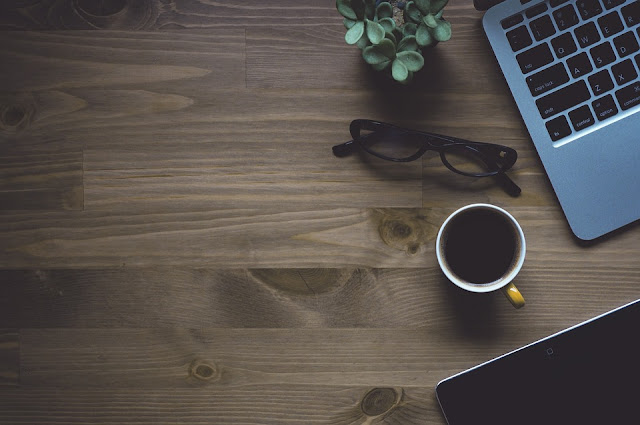 |
A cup of coffee and a laptop... (image via Pixabay)
|
It isn’t just about what you say
Sometimes it isn’t just about what you say to people, you need to be able to share and spread awareness with information that has the right level of facts and also information that supports what you are saying. This is when you may want to look online and find websites that are full of information on the subject, such as websites like https://www.wopg.org/ where peace of words and different speakers will help to share and express your views in a different way.Using digital platforms to your advantage
A great way to help share what you are doing and the changes that you are making to your life and the way that you live is to use digital platforms to help spears the awareness a little more. This could be easily done through already established personal social media channels that you have. It might be a case of sharing articles or speeches that mean something to you, or simply sharing what you are doing to make a change. You could also use an online blog to write about it in more detail. Sharing your articles with people and also helping them to spread awareness through the information and the content that you have written.Practice what you preach
Another option to consider would be to seriously practice what you preach. That might be things like living more sustainably. This could mean things like growing your own food, and recycling more. It could mean that you live more consciously, such as using less plastic on a day to day basis to help reduce the amount of consumption that is polluting our seas right now. You could also change the way your home is energised by opting for solar panels as an option instead. There are many ways that you can live in the way that you believe in, that doing so can help you to lead by example with others following.Find people that share the same view
Finally, it may be worth finding people that share the same views and opinions than you. This is different to seeking out confirmation on websites and through online blogs set up by others. This could be in your friends, your co-workers, and the people you lease with day in day out.Let’s hope these suggestions help you to live with an environmentally friendly focus in your life.
Celebrities, Entertainment Related, Halloween Related, Humour/Humor, Miscellaneous, Music Related, News Related, Video-clips
by Loup Dargent
October 28, 2019
 |
| Balt Getty - Loser Artwork |
"LOSER" brings a sense of humor and wit to the subject. Balt, himself, feels this way but yet travels the world, designs beautiful clothing, DJs some amazing parties, and still, sometimes he feels like a loser and an alien in this world. The song itself has a catchy melody that's easy to move and sing or rap along with. The lyrics are literally brought to lyrics through the music video, giving viewers an inside look on the real-life of Balt Getty; everything from his art to his clothing line, his drawings, his travels, his music. Intertwined with the lyrics as they're brought to life around the screen with playful effects that give the video some extra oomph.
The Video:
You may already be familiar with Balt Getty from one of his many feature films or TV roles or his newly launched clothing line/store Monk Punk. However, these days the recording artist/DJ is focused on his first love, music, and has been releasing under his alter-ego Balt Getty and working on his visionary collective Purple Haus Music, which has ignited collaborations for everyone from rap legends Wu-Tang Clan to Latin superstar Asdru Sierra.
Getty sheds some insight on his ideas behind the new release, "The song LOSER is about feeling different. Feeling like a loser, feeling like a creep, feeling like an outsider. And then drawing parallels with being a Vampire, needing blood to survive. A metaphor for needing attention, needing love. Needing all those things we're always looking for to fulfill ourselves, to fill that hole inside of us I guess. All with a sense of humor of course. Yeah, it's in the title. I'm a loser I'm a creep, I'm a weirdo, I'm eccentric. You know, all these things that are a part of me. We see one thing on the outside but often feel differently on the inside. It's sorta cheeky, witty look at that."
SOURCE: Balt Getty
26 October 2019
by Loup Dargent
October 26, 2019
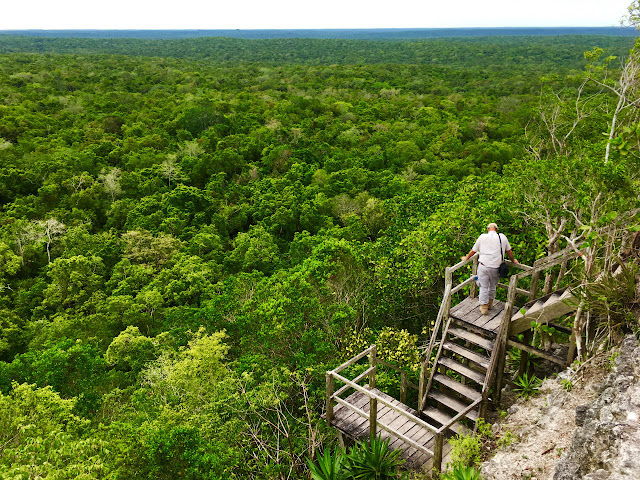 |
| Archaeologist Richard Hansen looks out over the Maya Biosphere he hopes to develop from a tower at El Mirador. ( Photo by Kelly McLaughlin.) |
"The future of the Maya Biosphere Reserve must lie in the hands of the Guatemalan people," said Teena Clipston, founder of the Maya Biosphere Watch, a coalition opposing the project. "They are the ones that need to make the decisions in what happens to their land."The jungle theme park is the brainchild of Dr. Richard D. Hansen, an archaeologist from Rupert, Idaho, and director of the El Mirador Archaeological Project in the reserve.
"We have a real live Disneyland here," Hansen said. "We don't have to invent anything. It's all here. Animals, crocodiles, tapirs, jaguars, ruins, jungle, macaws, parrots, toucans, it's all here," Hansen said in an interview at the El Mirador archaeological site.Though the plan has not been made available to the public, Maya Biosphere Watch reports that a 2018 executive summary documented plans for multiple hotels and a train that would traverse the rainforest, linking nine archaeological sites.
Clipston said forestry workers, archaeologists, and conservation groups in the area opposes the plan. The group believes the theme park would disrupt conservation efforts by forestry concessions and displace thousands of local residents, many of whom are descended from the ancient Maya, she said.
Hansen has hired a lobbying firm to seek out government assistance in Washington to raise the more than $100 million dollars for the project. Hansen has worked in the area for decades and has pursued this vision for at least 20 years. He believes it will be the salvation of the region, preventing deforestation, drug trafficking and halting migration to the U.S.
Conservation groups say the reserve is not in any immediate danger and insist that removing national parks and forest concessions would threaten the fragile rainforest environment.
They point to a 2017 report by Consejo Nacional de Áreas Protegidas, a government agency, that shows a net gain in the amount of forest within the Eastern MBR over recent years.
"Like most people," Clipston said. "I was lured into the idea of this proposal being beneficial to the people and the forest, but after further investigation I was disheartened."
Dr. Tomas Barrientos, codirector of La Corona Archaeological Project in the MBR, says "The role that local communities have played in the preservation of nature must be taken into consideration."
Dr. Francisco Estrada-Belli, a Guatemalan archaeologist and director of the Holmul Archaeological Project, openly voices his disapproval. "It concerns me that those outside the academic community who currently support Hansen's project genuinely believe he is working to benefit Guatemala, while the plan appears to be more about him having control of a large portion of the country than about benefitting Guatemala or science."
Roan Balas McNab, program director of Wildlife Conservation Society in Guatemala, says Hansen's plan would "undermine the social fabric of the eastern Maya Biosphere Reserve, one of the few Mesoamerican wilderness areas that is actually increasing in size.
Our call to Guatemalans, Mexicans, and the U.S. supporters alike is that they take a step back, debate the merits and challenges inherent in this proposal, and at all costs avoid a rush to judgement."
SOURCE: Maya Biosphere

Subscribe to:
Comments (Atom)




